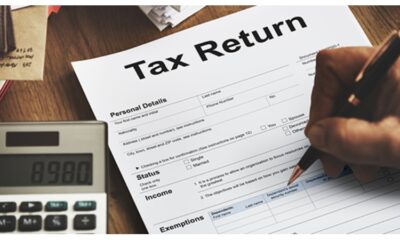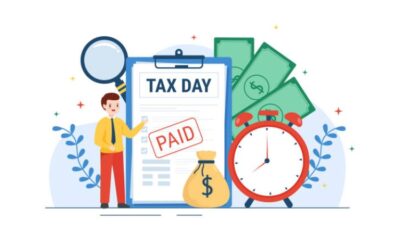Business
Best Ways to Taxes Deduction in 2024 and Tips for Optimising Your 2024 Tax Savings

All financial responsibilities inevitably include paying taxes. On the other hand, one important tool for reducing the tax burden is aggressive tax planning. Although the idea of having to pay large amounts of taxes may seem overwhelming, there are ways to lower tax obligations thanks to the Income Tax Act, which offers several ways to file deductions and exemptions.
Here’s the perfect time to review your tax projection and make investment plans as the fiscal year 2023–2024 draws to an end. An employee’s tax liability based on their salary income is calculated during this time of year when they rush to provide their employers with final tax proofs.
Investing in tax-saving government instruments:
Many government-mandated programs provide tax exemptions along with substantial returns on total investment. The Public Provident Fund (PPF), National Pension System (NPS), Sukanya Samriddhi Yojana (SSY), Equity Linked Savings Schemes (ELSS), National Savings Certificate (NSC), and others are examples of these schemes. With the help of these options, individuals can deduct up to Rs 1.5 lakh from their total taxable income under Section 80C.
Making the most of tax deductions over 80C
Even though Section 80C allows for a deduction of Rs 1.5 lakh for investments made towards life insurance premiums, employee provident funds, home loan principal repayment, tuition for the education of two children, and other previously mentioned expenses, one should also take into account potential tax savings outside of Section 80C.
Section 80CCD(1B) allows for an extra deduction of up to Rs 50,000 for contributions made to NPS. Employer contributions to NPS are also eligible for a deduction under Section 80CCD (2) of up to 10% of base pay.
A maximum deduction of Rs 25,000 is allowed to individuals for health insurance premiums covering themselves, their spouse, and any dependent children. An extra deduction of Rs 25,000 can be made for parents’ health insurance premiums. If any of the insured is a senior citizen, the Rs 25,000 limit is raised to Rs 50,000 (person of 60 years and above). Preventive health examinations are eligible for a deduction of up to Rs 5,000 per financial year, with a maximum total deduction of Rs 25,000 or Rs 50,000, depending on the situation. Up to the amount allowed by section 80D, medical costs incurred to maintain the health of senior citizens without health insurance are also deductible.
People can deduct interest paid on loans for education for themselves, their spouses, or their children under Section 80E. In contrast to other tax-benefit investment options, this section allows for an unlimited deduction up to the actual interest paid during the fiscal year.
Subject to certain restrictions, salaried individuals may still claim a deduction for rent paid under section 80GG even if their pay structure does not include the house rent allowance (HRA).
Individuals may deduct up to Rs. 10,000 in interest from savings accounts under Section 80TTA. Senior citizens can deduct interest earned on both savings and fixed deposits up to Rs. 50,000 higher than what is allowed under Section 80TTB.
Furthermore, donations made to specific charity funds or institutions may be deducted under section 80G. Depending on the fund, the deduction can be either 100% or 50% of the amount donated, with or without a qualifying limit.
Co-owning a House property:
Each co-owner who is responsible for paying the home loan interest on a self-occupied property may deduct up to Rs 2,00,000 from the total amount owed on the loan. It is crucial to remember that the total interest paid on the loan should not be greater than the total interest claimed by all owners/borrowers combined. Furthermore, under Section 80C, the principal repayment is deductible, with a maximum claim of Rs 1.5 lakh per individual.
If certain requirements are met, an additional deduction of Rs. 1,50,000 for affordable housing projects and Rs. 50,000 for home loan interest may be claimed annually under Sections 80EE and 80EEA. To claim deduction under section 80EE, a home loan must be obtained between April 1, 2016, and March 31, 2017, and between April 1, 2019, and March 31, 2022, for deduction under section 80EEA.
Salary-related exemption or deductions:
Housing rent allowance (HRA): Subject to certain restrictions, salaried employees who receive HRA as a part of their pay and have rent expenses can claim HRA exemption under the Income Tax Act, 1961, Section 10(13A).
Leave Travel Concession (LTC): Salaried workers who receive LTC as a part of their pay are eligible to claim an exemption for the real costs of travel for themselves, their spouses, their dependent children, their siblings, and their parents. This concession is available twice during a four-year period, which runs from 2022 to 2025 at the moment. It’s crucial to remember that payroll deduction should be the only method used to process an LTC claim.
Proactive planning avoids surprises
Commencing in fiscal year 2023–2024, the default tax regime will be the simplified one, requiring the waiver of the majority of deductions and exemptions. However, if the previous tax system works better, then go ahead and adopt it. Except for the employer’s contribution to NPS under Section 80CCD(2), which is available under both the regular and simplified tax regimes, it is imperative to note that tax deductions and exemptions are only applicable to individuals who choose the regular tax regime.
To sum up, to avoid any surprises when filing your taxes, you must plan and double-check your situation before the end of the year. The implementation of strategic tax-saving measures will guarantee a hassle-free and efficient income tax return filing process in addition to helping to lower tax liabilities.
-

 Sports4 weeks ago
Sports4 weeks agoAl Ahly vs Inter Miami, 2025 FIFA Club World Cup – Preview, Prediction, Predicted Lineups and How to Watch
-
Health3 weeks ago
Back to Roots: Ayurveda Offers Natural Cure for Common Hair Woes
-

 Tech3 weeks ago
Tech3 weeks agoFrom Soil to Silicon: The Rise of Agriculture AI and Drone Innovations in 2025
-

 Startup4 weeks ago
Startup4 weeks agoHow Instagram Is Driving Global Social Media Marketing Trends
-

 Sports3 weeks ago
Sports3 weeks agoFIBA 3×3 World Cup 2025: Full Schedule, Preview, and How to Watch
-

 Science4 days ago
Science4 days agoJuly Full Moon 2025: Everything You Should Need to Know, When and Where to See Buck Moon
-

 Gadget3 weeks ago
Gadget3 weeks agoThings to Know about Samsung Galaxy S26: What’s New and What’s Next
-

 Sports4 weeks ago
Sports4 weeks agoWorld Judo Championships 2025: Full Schedule, Date, Time, Key Athletes and How to Watch

























